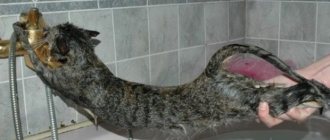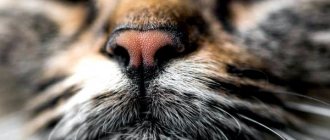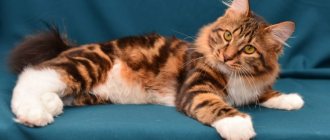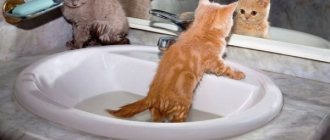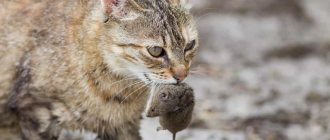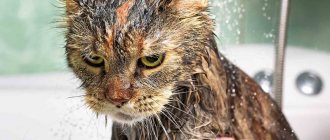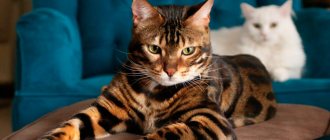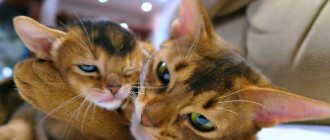According to research by felinologists, those cats whose natural habitat was near bodies of water love to swim. An additional advantage of such breeds is their hunting skills. The Kurilian Bobtail, Maine Coon and Turkish Van show a special love for water. However, almost every breed has representatives who are not afraid of swimming.
What breeds should you avoid?
Felinologists do not recommend having breeds similar to predatory cats: Chausie, Caraquet, Savannah.
They have a developed wild side, so cats use their fangs and claws to protect themselves. For example, representatives of the interracial Savannah breed are labeled F1-F7. The lower the number, the more wild blood the animal has. Such animals are suitable exclusively for aviary keeping.
The Chausie breed is also classified into 4 stages F1-F4. Cats marked F4 differ little in size from domestic cats and have the maximum level of socialization, but still are not suitable for families with children.
When should you wash your cat?
Cats themselves are clean animals, but despite this, experts recommend washing them in the following cases:
- heavy pollution, for example, after walking outside;
- formation of tangles;
- dullness and loss of shine of wool;
- treatment for various parasitic and infectious diseases, as well as allergic reactions using specialized means;
- participation in the exhibition - the animal is bathed using professional cosmetics to make the coat shiny and thick;
- scheduled haircut at the groomer;
- if for some reason the animal is forced to go to the toilet in diapers, you should approach the procedure carefully, since bathing can lead to a worsening of the current disease, so you should consult a veterinarian before carrying out the procedure.
What cats love water?
Despite the facts we have listed above, some cats are not deterred by the risk of infection or hypothermia, and even an attack by a larger predator does not frighten them. Almost all wild cats, regardless of size, regularly enter the water: to hunt fish or waterfowl, and sometimes just for pleasure.
Many wild cats enjoy bathing
Such wild representatives of the cat family as tigers, Sumatrans, servals, jaguars, wiverins splash in the water with pleasure, and even play with the splashes and waves. There is even an Asian cat, which is called a fish cat - it lives near the water and feeds exclusively on fish. The fish cat dives well and swims confidently, getting food.
Domestic cats that are not afraid of bathing are also common. Many pets drink water from an open tap or toilet, play with the water stream, and some even jump into the shower or bathtub, despite the water being turned on or the shower running. There are even unique people who take water treatments together with their owners, completely voluntarily!
There are cats that can play in the water for hours
Selkirk Rex
Playful and curious, the Selkirk Rex can play near the water while you wash the dishes or even take a shower. Affectionate and curious, Selkirk Rexes hate to be left alone and follow their owners around the house.
It turns out that not all cats are afraid of water:) Do your cats like to swim? Share your stories in the comments!
How to accustom a pet to water procedures?
A kitten should be accustomed to water when it reaches 2 months. It’s not worth doing this earlier, because the baby’s immunity is not yet strong enough. If you start training much later, there is a risk of encountering problems, because kittens are more open to everything new.
You need to start getting acquainted with water gradually. To begin with, it is recommended to fill a small basin so that only its bottom is covered. It is desirable that the walls of the container are low. It is necessary to cover the basin with a rubber mat so that the pet’s legs do not move apart and he can stand confidently. The kitten will touch the water only with its paws, and this will be the end of its first experience with water. Next time, add a little more water, then fill the basin to such a level that the water touches the pet’s stomach
It is important not to create large “waves” so as not to scare the cat
After the kitten has been in the basin several times, you can begin bathing in larger containers. The bottom of the bath should also be covered with a rubber mat. Turn on the water from the tap to a minimum, its temperature should be about 39°C.
If the cat breaks out and clearly does not want to take water procedures, you should not force it. This will strengthen the dislike for washing and undermine trust in the owner. It is better to wrap the cat in a towel and take it to a warm room.
It is better to dry the animal's fur without using a hairdryer, so as not to frighten the pet with noise. You should stock up on several towels, wrap the cat in them one at a time and change them when they get wet.
How to accustom a cat to water and bathe it at home
You need to accustom your cat to bathing from childhood; They try to interest an adult cat and switch his attention from water to something very interesting. Not every cat can be accustomed to water, especially if it has already experienced a traumatic experience of forced “bathing”.
Accustoming to bathing should be gradual:
- you should study, observing which objects or phenomena accompanying the bathing process cause aversion in the cat, and consistently accustom him to them;
- if the cat does not want to be in the bathroom, then with the use of toys and treats you can ensure that he begins to willingly go there; the same thing - if the cat does not like the sound and sight of water flowing from the tap;
- you can begin to teach your cat to sit calmly in the bathtub itself either in the absence of water or with a minimum amount of it, by putting toys in there and inviting the cat to play;
- the bottom of the bath should be covered with a rubber mat to stabilize the cat;
- It is also recommended to take care of providing the cat with the opportunity to quickly leave the bath of his own free will, for example, by lowering the steps - this way the cat will not feel trapped and will become more confident and positive.
When the cat calmly tolerates both the bathing environment and being in the water, you can begin to wash it:
- For washing, only specialized detergents for caring for cats are used;
- When bathing a cat, it is important to protect his ears from water; to do this, you can insert tampons made from cotton pads into them;
- the water level in the bath should not be higher than the cat’s chest;
- if the cat does not like to be in the bath, perhaps a basin will be a compromise;
If your cat is afraid of the bath, you can try bathing him in a basin.
- water temperature - 38–39 °C;
- It is imperative to praise and encourage the cat in every possible way for its interest in swimming and playing in the water;
- bathing a cat using detergents is allowed no more than once every 2–3 months;
- after bathing the cat, you need to wrap it in a terry towel and hold it in your hands for 15–20 minutes, so that the fabric absorbs excess liquid, and only then release it;
After bathing the cat, you need to wrap it in a towel.
- if the cat is not afraid of a hairdryer, then you can try drying it with it; otherwise, you shouldn’t even try, so as not to disturb the cat;
- While drying the cat, you should avoid exposing it to drafts and low temperatures and, if necessary, dry the cat's ears.
You should not bathe:
- pregnant cat;
- cat within a month after vaccination;
- sick pet;
- the animal in the postoperative period until the sutures are removed;
- in winter;
- if you still can’t get your cat used to bathing.
If the cat is persistent in his desire to avoid bathing in the shower or bath despite all the measures taken, he should be recognized as having this right.
You can make your cat's fur clean by:
- using sanitary napkins for animals for local contamination;
- You can remove dirt using water and zoo shampoo only on contaminated areas; the cat will tolerate this much better than a bath or shower;
- using dry shampoo or shampoo in mousses, gels: the cat’s fur is combed out;
- shampoo is applied;
- This is followed by the period of exposure of the shampoo specified in the instructions;
- then the cat is combed again with a comb, first with large teeth, and then with small ones; dry shampoo particles absorb dirt without drying out the skin and are removed with a brush;
- when cleaning the cat’s fur, it is better to place it on a newspaper or in a box, or use a vacuum cleaner to remove the remaining shampoo;
Photo gallery: means for cleaning cat fur without washing
Gel shampoos do not require rinsing and make combing hair easier
There are dry shampoos for both long-haired and short-haired pets
A small amount of shampoo-mousse lasts a long time
Napkins are convenient to use while traveling
Video: bathing a cat
Egyptian Mau
The Egyptian Mau is a medium-sized cat with short, spotted fur. The breed is adaptable. These cats can successfully adapt to living both indoors and outdoors.
This breed has first-class hunting skills and, with free access to the street, will often delight its owners with the prey it brings into the house. Mau has a pronounced affinity for water. She can often be found playing with the tap. Representatives of this breed enjoy taking a bath. They do not hesitate to drink water from the toilet.
The degree of love for water of a particular cat depends not only on its breed, but also on the character of the animal. Those pets who really like to get their paws wet will not mind joining their owner in the bath.
Siberian cat
You might think that a Siberian with such fluffy fur should be afraid of water. However, where have you seen Siberians afraid of something? This is exactly how fearless your pet is. He is ready not only to go hiking in the mountains with you, but will also be happy to accompany you while swimming in the lake, because he is an excellent swimmer.
Lent and children: what children can and what they should avoid
Cutlets are many times tastier, although the ingredients are the same: we make a luxurious roll
Looks like a child: how monkeys eat candy (video)
Bengal
The Bengal cat visually resembles an inhabitant of the savannah. It is distinguished by its exotic coloring, indicating a close relationship with the wild Asian leopard cat.
The Bengal does not have the wild habits of its predatory relatives, but has inherited from them a love of water. The breed is completely domesticated. Its representatives, living side by side with people, differ little in behavior from other domestic cats. They are playful and affectionate, incredibly dexterous and fearless.
The Bengal's lack of fear of water allows him to carry out hygiene procedures in the bathroom without any problems. The cat willingly allows itself to be washed by its owner. The animal does not miss the opportunity to splash around, play with water streams, or put its paws into an aquarium with fish. Owners often find their furry pet lying in a wet basin, sink or bathtub. The shower turned on and the sounds of flowing water do not frighten him like other domestic cats. The Bengali won't have to be caught all over the apartment to be ransomed. He will gladly allow the owner to bring his fur into proper shape.
A friend's stupid idea led to the fact that we are now trying to find homes for 3 cats.
What you need and what you don’t need to do while bathing
Before the procedure, veterinarians recommend thoroughly combing the cat and removing tangles. Then insert cotton balls into your pet's ears or put a special cap on his head. After this, the massage mitten is moistened in water, and a detergent is applied to its surface. After foaming, the shampoo is gently rubbed into the animal’s fur with massage movements. There is no need to press hard, otherwise it will scare the animal even more, and then it will be much more difficult to restrain it.
Bathing a cat in a basin
If you are planning to bathe your cat in a basin, then place it in the bathtub. It is better to line the bottom of the basin with a terry towel or rug so that the cat does not slip. The room in which bathing takes place must be cleared of foreign objects, otherwise they risk ending up in the bathtub (basin) or, worse, on the cat’s head.
Water is also important when bathing an animal. Its temperature should not exceed 40°C and be at least 36°C
Veterinarians pay attention to the proper water level. It should not be higher than the level of the pet’s stomach
Therefore, there is no need to fill the bathtub (basin) to the top. If the cat does not feel the bottom under his paws, this can greatly frighten him.
Thermometer for measuring water temperature (without mercury)
Be sure to trim the animal’s claws before the procedure.
It is very important. This way you will protect yourself from possible scratches and damage.
There should be no loud sounds, screams, or pressure. Try to be calm and affectionate.
It is more convenient to bathe a cat together. Immediately assign roles - who will hold the animal and who will bathe it. It is better to entrust the bathing process to the person the cat loves most.
Maine Coon
Noble cats with indescribable beauty, extraordinary color, large bodies, tufts at the ends of the ears, look like a lynx. In relation to the body, they have the longest tail, in which they can wrap themselves, like in a blanket. Huge slanting eyes of amber, golden or green color, thick fur create the image of chic cats. And to beauty you can add a playful character and a friendly attitude towards people. Maine Coons distinguish the tone of a person's voice and remember all commands.
They relate well to water and love to swim. The breed has thick, long, silky hair, so special care is needed to maintain its beauty. It is recommended to purchase bathing shampoo and conditioner for long-haired breeds from veterinary hospitals. Dirt on the fur or fleas serve as a signal for a bath. There are special hypoallergenic shampoos for small kittens. However, remember that the Ph balance of animal and human skin is different, so you cannot wash cats with human hair shampoo.
But you shouldn’t abuse this procedure; cats take care of themselves perfectly well. You need to bathe once every three months
It is important that while bathing the kitten and getting used to the water, the owner’s even, calm, soothing voice sounds. An adult cat actively plays while bathing, catches a stream of water, and pleases its owner with its mood
Japanese Bobtail
The long-legged cat with a muscular body looks like a powerful predator. A distinctive feature is a small tail, like a rabbit's. An energetic, impatient cat who loves to hunt, he is friendly in the family. There are long-haired and short-haired breeds.
They treat water very well, bathing in the bathtub or in the river brings pleasure to this breed, but bathing more than once every three months is not recommended; the cat takes care of its hygiene on its own. When bathing, you need to be very careful with the cat's tail, because it is a vulnerable part of the body.
American Bobtail
Cats with a hunting look and a hare's tail are very similar to wild cats. Their attractive appearance makes them very popular. The animals grow very slowly; it will take the American Bobtail about three years to fully mature. The breed is friendly, willing to meet guests, and sociable.
You need to bathe your bobtail when it gets dirty, but not often. The animal carries out hygiene procedures on its own. Although he treats water well and loves the gentle hands of his owners, you should not abuse water procedures.
In order for a cat to love water, you need to accustom the kitten to bathing from childhood. Then this process will bring a feeling of joy, pleasure, delight and satisfaction to both the animal and the owner.
How to prepare a cat for a bath
Before carrying out the procedure, it is necessary to prepare the work space: place shampoo and a large terry towel within easy reach. You should also set a comfortable water temperature - about 39 degrees. Under no circumstances should you wash your pet in cold or hot water.
To reduce the noise produced by water, you should first fill the bath with a small amount of water and also reduce the shower pressure, in which case the cat will experience less stress and will tolerate bathing better. The ideal option is to stop using the shower. To do this, you need to prepare a sufficient amount of warm water and a ladle or small saucepan with which you can water your pet.
About one day before the planned bathing, it is recommended to comb your pet thoroughly so that if water gets in, lumps and tangled strands do not form.
It is recommended to place a rubber mat or terry towel at the bottom of the bath to prevent the cat from slipping on it.
Before placing the cat in the bathroom, shampoo is poured into a specially designated container and diluted in water to form abundant foam.
Why are most cats afraid of water?
According to research and observations of felinologists, many cat breeds avoid contact with water as much as possible due to the following reasons:
- First negative experience. If a kitten is exposed to forced bathing, which includes the use of detergents, then it will develop unpleasant associations in the future.
- Chance of hypothermia. Between the skin and fur of the cat, the air mass will be happy, constantly heated by the body temperature and protecting the animal from hypothermia. However, the ingress of water destroys the layer and minimizes the heating effect.
- Disappearance of overheating protection. The layer of air that disappears when wet also performs a cooling function, as it impedes the penetration of sunlight.
- The appearance of a pungent aroma. Wet fur has a specific smell, which in the wild would be fraught with the loss of prey, which sensed the approach of a predator in advance.
- Creating a humid environment. In wet wool, dirt and dust particles get stuck more easily, and pathogenic microorganisms multiply faster.
There really are breeds of cats that love water.
Cat owners are well aware of their pets' dislike for water treatments.
Getting an animal that licks its fur with such zeal into the bathroom is a big problem. A cat can sit near the water tap, watch the stream and even drink it, but when it comes to washing, most four-legged pets are categorical - fanning claws and loud dissatisfaction. By the way, this behavior is quite understandable, and we have already written an article about why cats don’t like to get wet, we recommend reading it.
Source: news.myseldon.com
However, dislike of water, as it turned out, is not characteristic of all breeds. Our article will help you find out whether your cat will bask in the bath or jump out of it as if scalded.
Cat breeds that love water
As you know, rules have exceptions. There are breeds that have the opposite tendency and love water treatments.
Turkish van
Representatives of this breed approach swimming as an art: they are not afraid of water and love to swim. These cats, which have been fishing in Lake Van since ancient times, can dive. They have no undercoat, so water treatments cause them much less discomfort than most breeds.
Turkish Angora
If not a fan of swimming, she definitely likes to play with water. Kittens that are taught to swim by their mother are almost guaranteed to swim. However, such animals are rare.
Maine Coon
Many coons prefer to drink not from a bowl, but to dip their paw into the bowl and then lick it. They spray more than they drink, but it's even more fun. Maine Coons have a special relationship with their bowl. Often before drinking, they dig for a long time near it, turn it over and spread the water throughout the house. Therefore, choose massive and deep drinking containers. Please note that individuals of this breed do not like to take long showers.
Bengal
Like previous individuals, they love to suck their paws. These are unusual cats with interesting qualities:
- are not afraid of water;
- are friends with dogs;
- easily accustomed to a harness;
- love walks;
- They steal no worse than forty.
Abyssinian
Although the Abyssinian does not have an undercoat, its representatives do not like to swim. However, almost everyone is a fan of flowing water. They also love basins or containers with something interesting - or dirty.
American Bobtails
The vast majority classifies this breed of pet as one that loves water, but most American cats are not afraid of it. In addition, they are attracted to the fact that they can play with the liquid.
Kurilian Bobtails
Like Turkish Vans, Kurbobs are devoid of undercoat, and they love water. How else to survive in the Kuril Islands? True, most representatives of the third or fourth generation of the breed, living far from the Kuril Islands, treat water like any ordinary cat - with disgust and distrust. In a city apartment, a mother is unlikely to be able to teach kittens to love fishing.
Manx
A native island breed from the Isle of Man that loves water. They can play with the streams and even climb under them, but owners should not relax when they decide to wash the cat: it’s one thing when you get into the water yourself, and another thing when they forcefully water and soap it.
The habit of Manx cats to have fun with liquid substances is often attributed to Maine Coons, confusing the breeds due to the consonance of the names. These are different animals with different habits: Manx prefer to show in water, Maine Coons prefer to show in it.
Sphinx
These cats are rarely mentioned among those who do not like water. Hairless cats prefer a warm bath, at a temperature slightly higher than their body - 38.5 degrees. They are one of the few cats quite capable of deciding to take their first bath in adulthood on their own, imitating the owner lying in the bathtub. The liquid does not cause them significant discomfort, since there is nothing special to get wet or dry.
Even those breeds of cats that are supposed to love water are not obliged to entertain their owners by frolicking in the bathtub. Moreover, they may sincerely despise water, like most of their fellows. Therefore, if you want your pet to easily allow himself to be bathed, introduce him to the bath gradually.
Use it when the animal begins to have a good and positive attitude towards water. It is better to lay a towel at the bottom of the cat’s bathing container so that the cat’s paws do not slide on wet enamel or plastic, eliminating the fear of slipping. And most importantly: even a cat who is ready to allow himself to be washed can be irritated with water by pressing too hard or abruptly and unexpectedly dropping him into the container.
Why do dogs love to swim so much, unlike cats?
This can be explained by several facts. The structure of a dog's fur is different from that of a cat's; as a rule, it is thinner and longer, and water drains easily from it. Dogs carefully shake off their fur when leaving the water. Also, in dogs, thermoregulation is additionally regulated by breathing activity. If it's hot, the dog sticks out its tongue and breathes quickly.
A dog’s specific smell is present even when the coat is dry, so getting it wet doesn’t really change anything. Dogs by nature are pack animals and hunt by stalking rather than tracking prey. And they are not particularly afraid of predators; they are unlikely to suddenly attack an entire flock.
Some people love to keep company with the owner while he is taking a shower, while others like to cool off under the stream of water pouring from the tap. Often these are breeds such as: Bengal cats, Siamese, Somalia, Orientals, Thais, Turkish Vans, Angoras, Sphynx, Rex, Kuril Bobtails, Savannahs, Abyssinians.
Why cats don't like water
Animal experts, zoologists, animal psychologists, veterinarians and professional breeders do not know the exact answer why many cats cannot tolerate swimming in water. Presumably, there are two options that at least somehow reveal the veil of secrecy:
- The first assumption is the origin.
The ancestors of domesticated cats are African cats. They lived for centuries in hot deserts, not adapted to humidity, which is difficult to find. During the rainy season, instead of bodies of water, these cats encountered turbulent streams of water, washing away everything in their path. This version is confirmed by observations of lions. Despite the fact that lion prides are in the hottest weather, these maned giants prefer to drink water rather than take a dip if possible. - The second assumption is the hunting instinct
. Most cats have thick fur, which, when wet, spoils the cat's entire hunt. This is due to the peculiarities of the structure - the process of thermoregulation and microcirculation of air in the fur of cats and dogs is significantly different. Thus, sudden wetness leads to a rise in body temperature, the fur will begin to smell, which for a real hunter in ambush means complete failure.
In addition to the above assumptions, it is also important to note the suddenness of the situation. Pouring water provokes a state of shock in the animal
In the process of washing a resisting cat with shampoo in the bath, the animal freezes, and the noise of the water, the aromas of the detergent and other factors provoke severe discomfort in the pet. Finding itself in such a situation, the cat begins to panic, sensing approaching danger. Therefore, the reason for a cat’s fear is not the water itself, but the feeling of wet fur and extraneous sounds.
At the same time, despite their dislike for water, cats are excellent swimmers.
Only primates are poorly oriented in water, just like humans. Giraffes are also not considered the best swimmers. The love of swimming and the ability to be in it are two completely different concepts. The vast majority of representatives of domestic cat breeds do not like to bathe, since they do not need it at all, even from a hygienic point of view. Cats are very clean and can handle their fur on their own. It is also noted that excess moisture on the delicate skin leads to dryness.
The list of cat breeds does not include Sphynxes. They are avid swimmers, like some other cat breeds. Experts note that the fear of bathing can be dulled if, from a very young age, the kitten is gradually accustomed to water and water procedures (like children). When bathing, do not use detergents, and be sure to blot the fur after the procedure with a soft towel.
In theory, you can teach your pet to bathe, but cats are capricious, so they won’t do anything they don’t like. At the same time, the pet can calmly fish in a basin or small pond without fear of getting wet, or play with a drinking fountain or a small stream of water.
The desire to bathe is largely determined by the character of an individual cat. Some owners who accustom a cat to water may overdo it, making the cat disdainful towards water to the point where it starts lapping up water from the toilet.
Abyssinian cat
The funny and energetic Abyssinian is easily recognized by his silky ticked coat. Abyssinians are independent, but love to be a part of their owner's life. Their active, playful nature and boldness often attract them to the water, and they can be excellent swimmers.
Manx
www.adventurecats.org
The most famous tailless cat completes our list of water lovers. According to legend, she lost her tail while jumping onto Noah's Ark at the last moment - her luxurious long tail was simply cut off by the closing door.
Not all Manx cats like to swim, but the sight of a stream of water seems to hypnotize them all without exception. They can sit for a long time and watch the flow of water from a tap or the operation of a toilet flush and often even understand what to do to achieve what they want. This is a very affectionate and friendly breed.
https://youtube.com/watch?v=pgMUBfVr-VU
As always, we ask you to remember that each cat is unique and belonging to a breed does not guarantee a match with all the characteristics. In the end, regardless of love or dislike for water, attitude towards people and animals and other features, it is very difficult not to fall in love with these charming purring creatures.
How to properly wash a cat?
It’s one thing to teach your pet to stand calmly in the water or even move around within the bathroom; it’s another thing to wash it. The preparation rules are the same - warm water is poured into a basin or bath in advance so as not to frighten the animal with the noise of the flowing water stream. Place a non-slip mat on the bottom. It is better to call a second person for help who can hold the animal while it is soaped and then the shampoo is washed off.
You can wet your cat and wash off the foam with a shower, choosing the weakest pressure
To wash cats, only specialized pet shampoos are used that do not dry out the pet’s delicate skin. You also need to have a small ladle on hand, with which you need to gently wet the animal. You need to talk to the cat kindly, holding it so that it does not slip or jump over the side of the bathtub.
Tips for choosing shampoo for a cat
The shampoo does not need to be immediately poured onto the animal, you need to warm it and foam it in your hands, and only then transfer it to the fur. Human movements should be light, massage, care must be taken to ensure that foam does not get into the eyes, and water does not get into the pet’s ears.
After the cat has been washed and the remaining shampoo has been washed off, you need to flush the bath and wrap the animal in a large towel or terry sheet. It will take some time for the fabric to absorb excess moisture. A wet cat should not be released on the floor so that it does not freeze and catch a cold in the draft. When the fur becomes barely damp, the pet can be licked.
Cat breeds that love water
There are exceptions to all rules. And cats too. There are breeds of cats that not only tolerate water, but also sincerely love it, loving water treatments. List of breeds that love water.
Turkish van
Cats of this breed not only love water procedures; for them, bathing is a specific ritual. According to legend, cats of this breed were engaged in catching fish from Lake Van, obtaining food for themselves. In this regard, the Turkish Van not only loves to swim, but can even dive. A special feature of this breed is the absence of undercoat, so water does not cause discomfort when drying.
Turkish Angora
Belongs to those breeds that do not disdain when in contact with water. It is difficult to call them real swimmers, although if the mother cat herself loves to swim and taught her offspring to do so, the pet will love to swim.
Maine Coon
Large, handsome Maine Coon cats, in most cases, have the peculiarity of drinking water from a bowl without lowering their muzzle, but dipping their paw into it and then licking it off. Naturally, with this method of water consumption there is more splashing, but it brings great pleasure to small kittens. At the same time, the purebred giants do not intend to actually swim.
Bengal
Cats belonging to this breed are also distinguished by their desire to dip their paws in water and then lick off the residue from it. In addition to the fact that Bengals are not afraid of water, they get along well with dogs and will learn to walk well on a special harness, like real dogs, without any problems. At the same time, one sin has been noticed with Bengals - they are prone to theft, greedy for everything shiny, like magpies.
Abyssinian cat
The breed of pets, like the Turkish Van, is devoid of undercoat. But at the same time, these cats do not particularly like to take long showers or bathe with shampoo. But they are real fans of water, which does not get on their fur coat, frolicking with containers that contain liquid.
American Bobtails
It is believed that the American Bobtail truly loves water. In fact, representatives of this breed are tolerant of water and are simply not afraid of it. But like the Abyssinian cat, they don’t mind playing with liquids in containers.
Kurilian Bobtails
Unlike their close relative, the American Bobtail, these cats love water and lack undercoat, so long swims are not a shock to them. Over time, professional breeders began to notice that disdain for water and a certain distrust began to appear in this breed after several generations, raised far from the reservoir.
Manx
A real Aboriginal cat that lived on the islands in the distant past. Representatives of the breed are not averse to playing with streams of water. They may even wet themselves, but only on their own. If the owner tries to force the animal into the bathtub for washing, a serious conflict of interests may occur.
Sphinx
But this breed of cats are real connoisseurs of water. Having practically no fur, with the exception of small patches, Sphynx cats love to bathe in a warm bath. In this case, the water temperature should be slightly higher than their body (38.5). Even if a cat has not bathed in water until it grows up, an adult can climb into the bathtub on its own without any problems, especially with its beloved owner. Sphinxes do not feel any discomfort from being in water, since only their skin gets wet, and not the missing fur. And it’s much easier for such a cat to dry.
For owners' information, even if they have a cat breed that a priori loves water, you should not force the animal to bathe. Much depends not only on the breed, but also on the character of the individual animal. To minimize the risk of psychological trauma in an animal from bathing, it is recommended to gradually begin training. When bathing your pet, it is recommended to lay a terry towel on the bottom, preventing the risk of the animal slipping. The water pressure should be minimal, and the bathing product should not have a pronounced aroma. During the procedure, your pet should be praised in every possible way, encouraged with words, and under no circumstances should you raise your voice.
veterinarian - the answer will be sent to your email
Mr. Cat recommends: what products to use to bathe a cat
In order not to harm the condition of your pet’s fur and skin, you need to choose the right shampoo.
- Shampoo is available for oily and dry skin. In the latter case, they reduce the formation of static, add shine, and nourish. Some products contain sebum, that is, a fat-like substance that is secreted by the sebaceous glands, as a result of which the coat is covered with a protective layer. If your pet has oily skin, shampoo helps remove excess oil.
- If your pet has unkempt fur, you should choose a shampoo to remove tangles. The mechanism of action is that positively charged components come into contact with negatively charged hairs, causing the clumps to unravel. The product also gives a healthy shine and elasticity to the coat.
- Tinting shampoo is usually used in preparation for an exhibition to give the coat a pronounced shine and deepen the color. Such products contain coloring pigments that interact unstable with the hair, due to which they are gradually washed off from the pet’s fur. The use of such shampoos for bathing spotted cats is not recommended, as the white areas of the coat may lose their color.
- Lightening agent is used to whiten stains. Most often used before an exhibition.
- A special shampoo for breeds without hair, designed for high-quality skin care. Such products are presented in small quantities on the domestic market, and are also high in cost, so they can be replaced with children's hypoallergenic shampoo.
- Specialized medicinal shampoos are prescribed by a veterinarian to treat skin infections, treat fleas and lice.
For cats that really don’t like to wash themselves, spray or dry shampoos have been created. It is enough to spray them on the wool, and after a few minutes comb it.
Cat breeds with the most affectionate and calm personalities
Peace and tranquility in the house depend on the character of the pet. The affectionate and balanced cat spends his evenings in a chair with his owner, is loyal to children, and does not conflict with other animals.
Ragdoll
If you ask which cats are the most affectionate and calm, then you cannot find a better ragdoll breed. The name of the breed is translated as “rag doll”.
A large, but cute and clumsy pet, which was obtained by crossing Burmese and Angora cats, is absolutely devoid of aggression and the hunting instinct, and allows itself to be squeezed like a toy. The Ragdoll is kind, balanced, flexible, not talkative, and needs constant contact with its owner.
Shorthair exotic
A stocky cat with a flat nose and a touching expression on his face is popular all over the world. The breed is friendly, playful, and devoid of aggression. The pet needs the constant presence of a person, willingly participates in children's amusements, gets sick from loneliness and separation from its beloved owner, and has difficulty adapting to a changed environment.
Shorthair exotic
Russian blue cat
A sweet, affectionate, friendly pet readily communicates with children, treats guests with confidence, and gets along with a dog if it grew up with one from an early age. But the breed cannot be called affectionate.
The Russian cat easily tolerates short-term loneliness, does not like changes in environment, plays with the child whenever she wants, and is characterized by territorial behavior and restraint in showing emotions.
Maine Coon
Large native cat from the USA. Despite his harsh appearance, he is affectionate, flexible, intelligent, and amenable to training. The pet subtly senses the inner state of a person, is always open to communication, is friendly towards all household members, and does not shy away from guests.
Favorite pastime is sitting on the owner's lap. The attitude towards children is neutral, but it is better not to have a large cat with a developed hunting instinct for a family with a baby.
Burmese cat
In the photo, the Burmese looks graceful, willful, freedom-loving, a real predator. In fact, the breed has a gentle, sociable, cheerful character. The cat, infinitely devoted to its owner, tries to always be nearby, even sleep near the owner’s bed.
Burma loves to purr, looking into the owner's eyes, and the quiet and gentle voice of the cat calms and relieves stress.
Oriental
The description of the cat’s appearance is very exotic: huge ears, a narrow muzzle, an elongated and lean “oriental” build. Orientals are loved not only for their external originality, but also for their wonderful character.
The pet is non-aggressive, affectionate, non-offensive, talkative, friendly and trusting towards guests. Loves to play active games.
Siberian cat
Despite their autonomy and independence, “Siberians” become strongly attached to their owner and willingly participate in children’s games. The breed attracts with its balance, tact, intelligence, and spontaneous behavior. The cat is quiet and hardy.
Siberian cat
Sphinxes
Several varieties of Sphynxes have been bred, and all of them can be called the most tame cat breeds. The naked cat loves his owner immensely, loves to sit in his arms, and warm himself under a warm blanket in the owner’s bed. But it does not impose itself when the owner is busy.
Sphinxes lack aggression, are not touchy, and treat guests with trust. They react loyally to children's pranks and coexist peacefully in the apartment with other animals.
Persian cat
The breed is loved not only for its aristocratic manners and luxurious appearance, as can be seen in the photograph, but also for its kind, calm, affectionate character. “Persian” is phlegmatic, stubborn, plays according to his mood, prefers to lie on his master’s lap, and is indifferent to children and other animals.
He responds to love and kindness with endless devotion. The breed is in demand, widespread, the price of a purebred kitten is up to 30 thousand rubles.
Scottish fold cat
Phlegmatic, calm, sweet. He doesn’t intrude, he can spend hours watching a person go about his business. She is restrained in her expression of emotions, does not tolerate squeezing and noise, but becomes strongly attached to her owner and greets him at the door from work.
“Scotsman” is a good companion for a lonely person who does not like noisy gatherings.
Sphinxes
sphinxes love to swimsphinxes love to swim
Due to their lack of hair, Sphynx cats need to be bathed regularly from an early age and, as a result, love to be in water. Energetic acrobats, all Sphynx cats love to entertain their humans and crave human attention. Well-mannered and intelligent, the Sphynx makes an excellent house cat and can get along well with both dogs and other cats.
Cat breeds that are loyal to water
Yes, the relationship with water in domestic cats depends on how the first bathing experience goes, as well as on the character of the pet itself. The more curious and fearless the kitten, the more likely he is to enjoy the water element. Conventionally, we can distinguish the following breeds, whose representatives are more loyal to water procedures than others.
Table 1. Cat breeds that love water
Breed Characteristics
Sphinx
These hairless cats occupy the first place in the ranking of cat breeds that show an interest in water. This may be due to the lack of hair and the fact that Sphynx cats dry very quickly after bathing, and therefore do not experience discomfort. The only thing the owner needs to monitor is the temperature of the water so that the hot cat does not catch a cold or get sick.
Kurilian Bobtail
Bobtails have a high level of intelligence and are also very attached to their owner, so they follow him even to the bathroom. If the cat considers that the water does not pose a danger to it, it will be happy to accompany the owner during water procedures.
Abyssinian cat
Active and funny Abyssins, for the most part, are not at all afraid of getting wet. These are very mischievous cats, ready for energetic and active games in any form, so a representative of the Abyssinian breed will not be embarrassed by water splashes, which are so exciting to catch.
Maine Coon
Large and brave, these cats often accompanied sailors in the past, and nowadays they are loyal to the water. It’s not for nothing that Maine Coons are called “dog-cats,” and when it comes to bathing, representatives of this breed are more like dogs who love to frolic in the water
But, if a Maine Coon is afraid of water procedures, he will resist like a wild animal, so it is important to accustom the kitten to bathing as early as possible.
Devon Rex
Gentle and good-natured Devons, like sphinxes, have a very modest fur coat and dry quickly after water treatments. In addition, these cats are playful and good-natured, so it is enough to invite the Devon Rex to play in the bath for the pet to become interested in new entertainment.
Savannah
Energetic savannahs were bred by crossing domestic cats with wild ones, perhaps it was from such inbreeding that they developed a love for water
Many savannah owners note that these cats are not at all afraid of moisture, but on the contrary, they look for every opportunity to frolic in the water or play with water splashes. Savannahs kept in country houses sometimes even voluntarily swim in pools or outdoor fountains.
Bengal cat
By nature, Bengals are similar to Savannahs, and they have the same love for water. Spotted beauties happily cool off in the sink on a hot day, often ignore a bowl of water, preferring to drink running water from the tap, and also play in a filled bathtub or even basin.
Norwegian Forest Cat
These strong, large cats are not afraid of water, like their wild relatives. The stern Norwegian is quite ready to walk in the rain or heavy snow, and will also swim in a filled bathtub and even “hunt” for toys if the owner offers him such entertainment.
Turkish van
According to legend, a representative of this breed left Noah's Ark to swim to the Turkish shores. But the country greeted the cat with such unbearable heat that she plunged into the cold Lake Van, from where she got her name. Modern representatives of the breed fully correspond to the legend, and are extremely loyal to water in all its forms.
Egyptian Mau
These are cats with a very flexible nervous system, adaptable and curious, and this also applies to water procedures. The Egyptian Mau enjoys taking baths, playing with water streams and splashes, and even swims in artificial reservoirs without problems, if it has access to them.
Siamese cat
Independent Siamese cats are also lovers of water treatments. Owners note that cats jump into the bathtub or walk into the shower without fear, try to catch toys in the silt of a filled bucket, and do not run away from the irrigation system in the garden.
Most often, sphinxes like to bathe and even play in the bathtub
How to make addiction easier
You need to wash in a shallow basin standing on the floor. Little kittens experience an instinctive innate horror at the sight of high sides of the bathtub and pouring water. They associate them on a subconscious level with flooding, which means they are a command to escape. It’s good if the cat managed to get acquainted with the basin, sniff it, and play in it before bathing.
Bath a kitten from the age of 4 months
Before the process itself, put the kitten in a basin, let it get used to it and run around side by side. Pour non-chlorinated water into it, no more than 5-7 cm. The most comfortable temperature is 38-40 degrees. Place the kitten in the basin. Quickly wet his head, being careful not to get water into his ears and nose.
You need to be patient, do not scold or shout at the baby while bathing; it is better to calm him down with kind words if he meows loudly, showing fear. Do not delay the procedure.
After bathing, the baby should be wrapped in a warm towel, thoroughly blotted, and encouraged: milk, a favorite treat, a toy. If you are shaking, it means you are freezing, you need to change the towel to a dry and warm one, hold it in your arms, and calm it down. Use only special, hypoallergenic shampoos.
Note! Kittens aged 1-3 months should not be bathed unless absolutely necessary. The optimal age for the first wash is 4 months.
If the baby gets dirty in the cat litter box, it is better to wipe it with wet wipes or wash only the paws, but do not bathe the baby completely.
Egyptian Mau
Egyptian Mau
This is a short-haired cat with spotted coloring. Moreover, the spots are found not only on the fur, but also on the skin of the animal. The breed is adaptable. Cats successfully adapt to life both indoors and outdoors.
The breed has first-class hunting skills. Mau often brings his prey into the house. Cats of this breed are very attached to water. They enjoy the water treatment. They do not hesitate to drink from the toilet.
A cat's love for water is determined not only by the breed, but also by the character of the animal. Those cats who really like to get their paws wet will not mind getting into a bowl of water.
Burmese cat
The gentle nature of the Burmese allows them to tolerate water and bathing well. The adaptability of the breed, combined with early exposure to it, helps the cat to fall in love with bath procedures. With a dog-like temperament, Burmese are people-oriented, intelligent and energetic.
Bengal cat
Outwardly, it is very similar to its wild counterpart - the Asian leopard cat. But this particular breed is completely domesticated, and its representatives are in great demand among cat lovers.
The call of the ancestors still has echoes in the character of this animal; in the wild, cats catch fish and small animals from the water with deft movements of their paws. Living in the house, these habits still make themselves felt: not a single Bengal will be indifferent to the sound of flowing water or an invitingly filled bathtub.
Can all cats swim?
Despite the fact that cats prefer not to get involved with the water element, they are excellent swimmers from birth. Absolutely all representatives of the cat family can cover a considerable distance by water. Of course, this does not apply to newborn kittens, who do not have enough control over their bodies to be able to escape if they fall into the water. But already one month old kittens, if lowered to a sufficient depth, will work with their paws, scooping up water.
The ability to swim is an innate instinct of cats
All cats need swimming skills, as do any animals that go hunting. In case the mustachioed animal finds itself in a flood zone, drives its prey to a reservoir, or, on the contrary, the pursuing hunter drives it to the water, the animal is always ready to swim to save its life.
